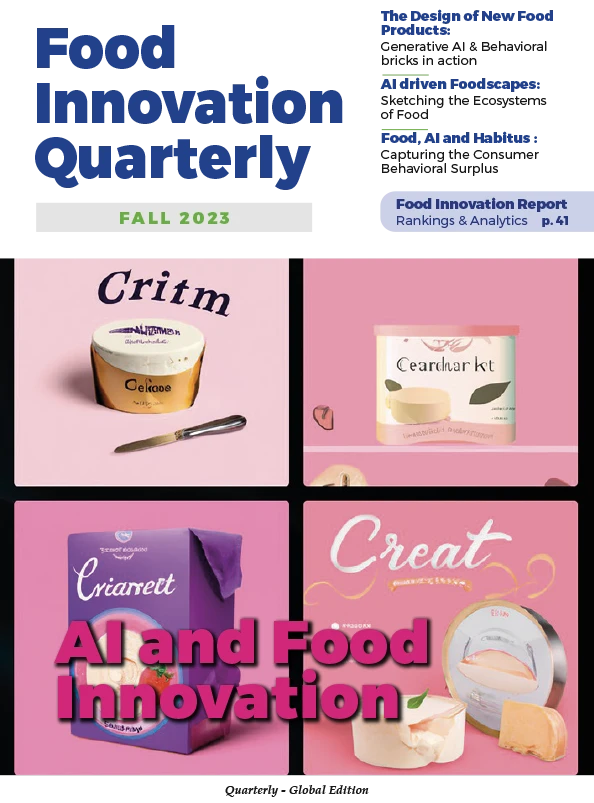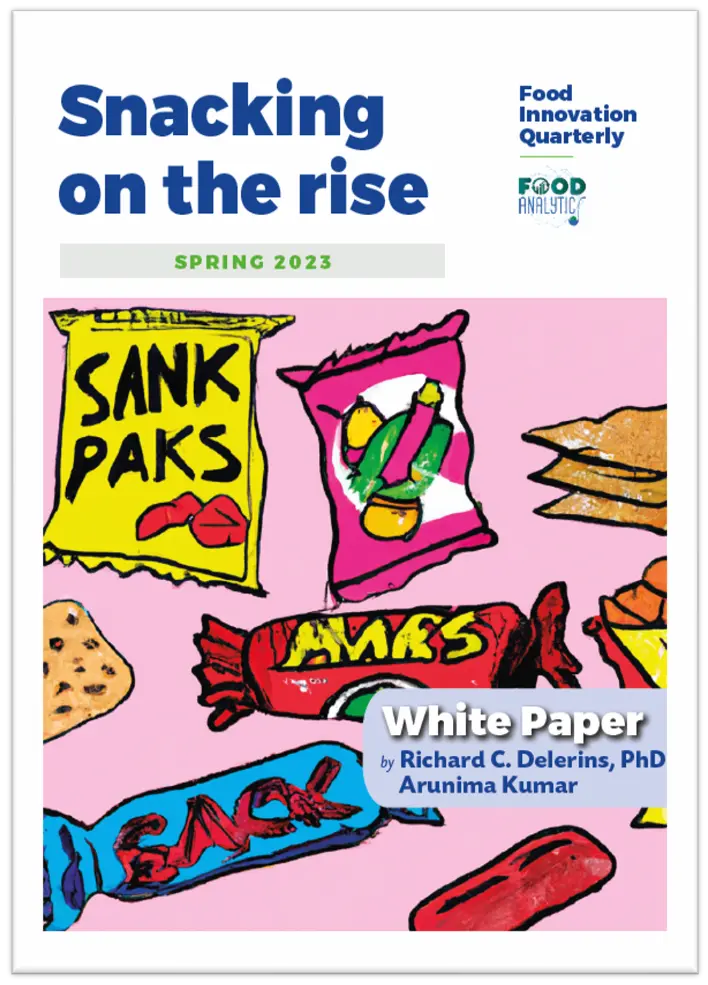When I first moved to Canada and made friends from various backgrounds, I noticed during our conversations about food that many of their dishes were similar to Turkish cuisine. We debated about the origins of Turkish food, pondering questions like whether kebab is truly Turkish or if its roots trace back to Greek traditions. Is börek a distinctively Turkish creation, or does it have Serbian origins? When it comes to baklava, is it more accurately described as Turkish or Lebanese?
Growing up in Istanbul, I never asked myself these questions or was especially interested in the history of our dishes. I set out to explore how Istanbul’s cuisine—with its remarkable blend of traditions from the Ottoman Empire, the Balkans, Greece, Kurdistan, Central Asia, and the Mediterranean—reflects its unique palette where such diverse flavors and culinary influences seamlessly come together.
Now, I’d like to introduce you to my favorite dishes, while also providing some historical context. Let me start by introducing my favorite dish, ‘mantı’.
Mantı: Turkish dumplings from Central Asia
Starting around the 6th century, Turkic-speaking peoples coming from Uzbekistan or Azerbaijan began migrating westward from the Central Asian steppes due to conflicts, the quest for new lands, and the pursuit of trade opportunities. By the 11th century, the Seljuk Turks, a prominent Turkic group, had firmly established themselves in Anatolia. Their decisive victory at the Battle of Manzikert in 1071 against the Byzantine Empire was a pivotal event leading to further Turkic settlement in the region. Along with their presence, they also introduced a wealth of their dishes and culinary traditions to Turkey.
One of these dishes is mantı, which reflects the nomadic lifestyle of its Central Asian orgin. It is a traditional Turkish dish of delicate dumplings filled with spiced minced meat, served with a rich yogurt and garlic sauce, embodying a blend of rustic flavors. Fried mantı is an especially delicious variation, and one of my favorites. Preparing mantı is a communal activity that brings generations together as they knead dough, fill dumplings, exchange stories and of course, gossip (also part of the tradition!).
My friends and I often indulge in mantı as a late-night meal, especially after a night out. Around 3 AM, we join the throngs of fellow revelers from the clubs, all savoring their own late-night snacks. This tradition is a cherished part of Istanbul’s vibrant nightlife. A popular spot for this experience is Bodrum Mantı, located in Arnavutköy—a charming, village-like area by the sea.
I enjoy having mantı with ayran. Ayran is a traditional Turkish beverage made from yogurt, water, and a pinch of salt. Turks drink it with just about anything—fish, meat, breakfast items, pastries, even spaghetti. However, most tourists do not like ayran, as it is something of “an acquired taste”. Personally, I LOVE it.
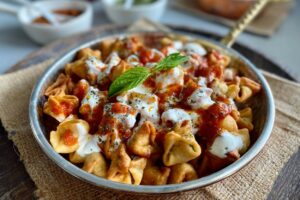
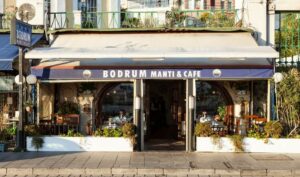
The most significant evolution in Turkish cuisine took place during the Ottoman Empire. Following Mehmet II’s conquest of Constantinople (now Istanbul) in 1453, the Topkapı Palace emerged as the heart of the Empire’s culinary scene. At this time, Turkish cuisine had matured into a sophisticated fusion of traditional nomadic practices and innovative techniques and ingredients from Persia. Mehmet II, a connoisseur of extravagant feasts, indulged in elaborate meals prepared by carefully selected chefs from Bolu in the palace kitchens.
The concept of the Turkish breakfast as we know it first took shape at Topkapı, where the sultan and his court would indulge in a lavish morning meal after prayers, prior to enjoying their coffee. This tradition is echoed in the Turkish term for breakfast, “kahvaltı,” which literally translates to “under coffee,” highlighting coffee’s integral role in this ritual.
“Breakfast must have something to do with happiness.”
Cemal Süreya, one of Turkey’s most renowned poets, once remarked, “Breakfast must have something to do with happiness.” This notion of joy is vividly embodied in Turkey’s diverse and delightful morning meals, which celebrate the country’s rich regional culinary heritage.
In Turkey, breakfast (“Kahvaltı”) transcends its role as a mere meal, evolving into a cherished social event that fosters family connections. It is not just the start of the day; it is a leisurely ritual, often extending across several hours. This tradition is epitomized by the serpme kahvaltı, or “sprinkling breakfast,” a lavish array of dishes that reflects an emphasis on abundance and enjoyment over haste. Sadly, I don’t have the luxury to indulge in such a breakfast daily; like many others, I reserve this for special Sunday mornings.
Now, imagine stepping into a Turkish kitchen on one of those leisurely Sunday mornings. The table is a feast for the senses: Beyaz peynir, a creamy white cheese, pairs with a selection of briny olives, while cherry jam and honey offer a touch of sweetness. Menemen, a flavorful scramble of eggs, tomatoes, and peppers, is served alongside crispy sausages and salami, with fresh tomatoes and cucumbers adding a crisp, refreshing balance. The spread is completed by simit, the Turkish bagel coated in sesame seeds, and poğaça, a buttery pastry filled with cheese or olives.

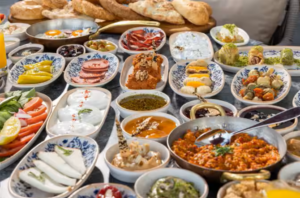
Take care—when invited to a traditional Turkish breakfast, finishing your plate is a sign of respect, and leaving food behind can be seen as ungrateful. Hosts often insist you have more, reflecting how deeply food and hospitality are woven into their sense of love and community.
You can also enjoy Turkish breakfast in restaurants such as Kaşıbeyaz, Baylan, Aşk Kahvesi, Emirgan Sütiş, all which come with a beautiful view of the sea.
Turkish coffee, known as ‘türk kahvesi’
Turkish coffee, known as ‘türk kahvesi’ in Turkey, traces its origins back to the Ottoman Empire, when an Ottoman envoy from Yemen introduced this unique coffee to Suleiman the Magnificent. He was so impressed by its rich flavor that he chose to elevate it to the status of Turkey’s preferred drink. Suleiman’s passion for Turkish coffee was so profound that he even had members of his harem trained in its precise preparation.
With its robust and intense flavor, it offers a unique sensory experience. Paired with lokum, or Turkish delight, the strong brew contrasts delightfully with the sweet, chewy candy, perfectly blending flavors and textures. There are several types of Turkish coffee you can try: damla sakızlı türk kahvesi (Turkish coffee with mastic), menengiç kahvesi (menengiç coffee) which is made with roasted pistachio or terebinth (a type of resin), and ‘gar’ coffee, even more intense than Turkish coffee, with notes of chocolate.
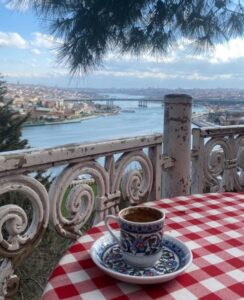
Turkish coffee is a cherished tradition enjoyed at any time of day—be it breakfast, lunch, or dinner. Serving it to guests is a mark of hospitality and respect, reflecting the Turkish emphasis on making visitors feel esteemed and welcomed.
Following coffee, many people indulge in a unique form of fortune-telling by interpreting the grounds left at the bottom of the cup. In many Turkish households, someone claims to decipher these patterns and symbols, adding a layer of folklore to the experience. While my own attempts at fortune-telling have rarely been accurate, the process is consistently entertaining. If you get the chance, I highly recommend asking a Turkish friend for a reading as it’s always a fun experience.
I love savoring delicious Turkish coffee at the ‘Pierre Loti’ coffeehouse, the oldest of its kind in Istanbul, where locals have been enjoying their daily caffeine dose for generations. Perched on Pierre Loti Hill in Eyüp, this historic spot is named after Loti, the French writer, who was deeply enamored with Istanbul. If you are looking to enjoy a cup of coffee in a very authentic decor with a beautiful view, this is the place to go!
The only way to reach this iconic venue is by taking a scenic cable car ride from Eyüp. Along the way, you’re treated to breathtaking views of the Golden Horn, a horn-shaped fjord on Istanbul’s European side. If that’s too much effort, you can always find any coffee shop in Pera near the Galata Tower—you won’t be disappointed.
Mezze: a Mediterranean sense of togetherness
In 1453, Ottoman Sultan Mehmet II captured Constantinople from the Byzantine Christians. He then invited affluent Greek Orthodox, Armenian, and Jewish merchants to participate in a mezze. The tradition of mezes is deeply embedded in Turkey’s historical and 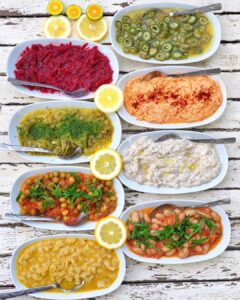 cultural heritage, originating from Mediterranean practices of the Greeks. In Anatolia, this cultural exchange allowed the concept of mezedes to blend with local customs, creating a vibrant culinary tradition that continues to thrive today.
cultural heritage, originating from Mediterranean practices of the Greeks. In Anatolia, this cultural exchange allowed the concept of mezedes to blend with local customs, creating a vibrant culinary tradition that continues to thrive today.
In the vibrant atmosphere of Turkish fish restaurants, or balık restorantı, mezes are more than just appetizers; they are an essential part of the dining experience. These small plates—ranging from creamy hummus and the distinctive pink tarama (a dip made from fish roe) to crispy fried calamari and tender grilled octopus—create a flavorful tapestry. Other favorites include a fresh seafood salad, the smoky baba ganoush, the cooling cacık (a yogurt and cucumber dip), patlıcan salatası (eggplant salad), and the spicy, tangy ezme.
When you visit these restaurants, you’ll find the table generously spread with these diverse mezzes, all meant for sharing and savoring together.
When dining with my family, our favorite dinner spots are ‘Kıyı Restoran’ in Tarabya and ‘Set Balık’ on the Asian side in Anadolu Hisarı, with its stunning view of the bridge connecting Asia to Europe. I have a slight preference for Set Balık because they serve fish meatballs (balık köfte). This dish is so delicious that it might make you want to cross the bridge from Europe to Asia, even with the horrible traffic in the city.

Börek: from the Balkans to your plate
Börek became a central element of Turkish cuisine during the expansion of the Ottoman Empire. As the Ottomans conquered and incorporated various regions, they amalgamated diverse culinary traditions, including those from the Balkans, where börek was already a staple.
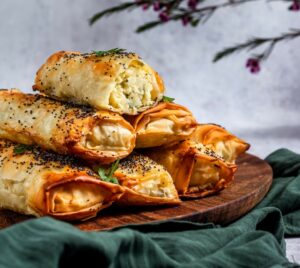
Börek is a culinary delight that captivates the senses from the very first bite. This savory pastry, made with delicate, paper-thin layers of filo dough called ‘yufka’, offers a satisfying crunch as you break through its crisp exterior. Inside is a rich filling that could be anything from melted cheese to spiced meat or fragrant vegetables. Popular varieties include ıspanaklı börek (spinach börek), peynirli börek (cheese börek), kıymalı börek (börek filled with kıyma), patatesli börek (potato börek), su böreği (water börek), sıgara böreği (börek in a cylindrical form), and kabaklı börek (zucchini Börek). I once attempted to make water börek, and it was a complete flop. If you manage to perfect it, please send me some tips!
I’ve noticed that börek varies not only from country to country but also within different communities in Istanbul. For example, the Jewish community in Istanbul refers to börek as “börekitas,” showcasing their unique cultural adaptation of the dish. Living in a predominantly Jewish neighborhood where I have many Jewish friends, I often encounter börekitas when invited at Shabbat dinners.
But, when I’m in the mood for börek and I feel like eating out with friends or family, I usually go to the ‘Meşhur Kireçburnu Fırıncısı’, home of the best böreks in Istanbul. The ‘water börek’ (Su Böreği) here is so irresistibly velvety and smooth that it presents a real challenge: can you manage to eat just one? If you’re going to indulge in a cheat day, make sure to visit on Sundays for brownies you will keep on craving long after you’ve finished them. You might also try the equally good ‘Tarihi Yeniköy Börekçisi’.
What to eat when in a rush?
I got you!
To start with some background, street food has a rich history spanning thousands of years. Initially developed as a practical solution for feeding the less fortunate, street food has evolved over time. In today’s globalized world, it often stands as the last stronghold of a region’s unique traditions and cultural identity.
In Istanbul, one of the most cherished street foods is the balık ekmek, a deliciously simple fish sandwich. This iconic treat features freshly grilled fish, crisp lettuce, and tangy onions, all nestled in a soft, fluffy white bread, and typically costs just 15 TL (about $2.60). Unfortunately, pollution and climate change have significantly reduced the local fish catch, leading many balık ekmek vendors to use frozen fillets imported from Norway instead of fresh catches.
For a taste of tradition, head to the historic and bustling areas of Eminönü and Sirkeci. These locations are renowned for their fish sandwiches for centuries.
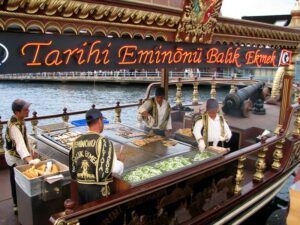
Another snack that you can find anywhere walking along the Bosphorus is ‘midye dolma’. Midye dolma consists of mussels on the half shell, stuffed with spiced rice and a touch of lemon juice, and is a popular street food available on nearly every corner in Taksim at night. The trick is to keep eating until you feel comfortably full, as the rice expands in your stomach. If you eat too quickly, you might end up with an empty wallet and an uncomfortable fullness before you realize it.
It’s all about the sesame
Earlier, I mentioned ‘simit’ as a part of the Turkish breakfast experience. Simit is Turkey’s own take on the bagel, a round bread covered in sesame seeds, and it can be enjoyed soft or crunchy, depending on your preference. Traditionally, it’s eaten for breakfast with tea, but it’s also commonly sold by street vendors in Turkey. These vendors either carry simit on trays balanced on their heads or push the simit trolleys. To find them, just listen for their call out in the streets, “Simitçiiiiii” (simit vendor).
The first simits were made during the Ottoman Empire. According to some accounts, the original simits were as large as a wagon wheel and were made for the public. However, as flour became more expensive, smaller simits called “hurda simit” began to be produced. Simit quickly became popular due to its filling nature and low cost, and over time, it became a staple food seen on every corner. It was so beloved that it even found its way onto the tables of the Ottoman palace.
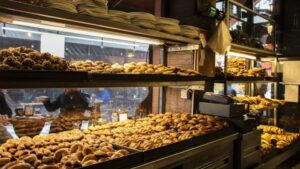
The second most popular pastry is poğaça. Its taste is so wonderful because its soft, fluffy dough and delicious fillings like cheese, potato, or olives topped with sesame seeds create a perfect harmony. It also delivers an interesting hint of sweetness. The smell of freshly baked, warm poğaça is quite unmatchable. Additionally, the poğaça often brings back sweet memories of my mom making them at home for family gatherings. It can be easily baked at home, so many families love to make poğaça when inviting friends for breakfast. If you happen to go to Istanbul, be sure to try the ‘dereotlu poğaça’ (dill poğaça) and thank me later. I think it should even be sold in duty-free shops.
One very good but less popular pastry is ‘tahin çöreği’. The dough, slightly sweetened, is wrapped and rolled with a filling of sweetened tahini paste. It’s then topped with sesame seeds and baked. Like a cinnamon roll, the inner layers are soft and tender, while the exterior is slightly firmer and crunchy.
‘Tarihi Oktay Kurabiye Fırını’ in Beşiktaş is the go-to spot for artisanal pastries. In addition to their pastries, you can also savor a wide variety of delicious biscuits.
Beyond kebab: iskender and hündar beyendi
Iskender is the most underrated dish that I know. I usually have it when we travel by car from one city to another in Turkey with my family. On the roads, you always find an Anatolian restaurant where they serve Iskender. Döner, which is the main ingredient, is meat that is cooked on a vertical rotisserie and then sliced very thinly. But, what makes İskender special are the layers of butter, tomato sauce, yogurt on the side, and the fatty pieces of pita bread underneath the meat. Also, because of the oil, the pita bread gets very fluffy. Now imagine the taste!
Hünkar beğendi is also on the top of my list of meat-based dishes. This Ottoman dish combines eggplant and meat. The eggplant is grilled until the skin is charred to give it a smoky taste, then pureed, seasoned, and blended with béchamel sauce. The resulting mixture is topped with cubes of sautéed or grilled meat.
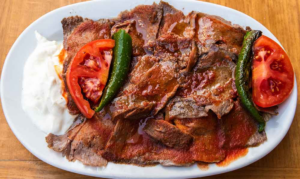
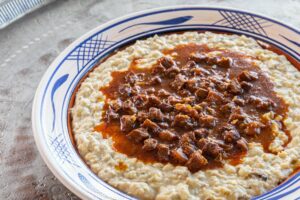
For over 10 years, I’ve been going to the same restaurant called Develi in Etiler. From there you can observe some skyscrapers in one of the business districts, Levent. The contrasting juxtaposition of traditional cuisine and modern skyline makes it a unique atmosphere that I love.




